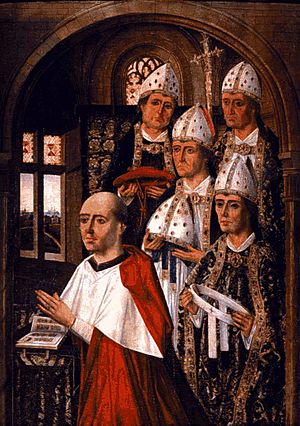Pedro González de Mendoza facts for kids
Quick facts for kids |
|
|---|---|
| Cardinal, Archbishop of Toledo Primate of Spain |
|

Portrait of Cardinal Mendoza by Juan Rodríguez de Segovia (c. 1484).
|
|
| Church | Roman Catholic |
| Archdiocese | Toledo |
| Appointed | 13 November 1482 |
| Reign ended | 11 January 1495 |
| Predecessor | Alfonso Carrillo de Acuña |
| Successor | Francisco Jiménez de Cisneros |
| Other posts | Titular Patriarch of Alexandria (1482–95) Cardinal-Priest of Santa Croce in Gerusalemme (1478–95) Bishop of Sigüenza (1467–95) |
| Orders | |
| Consecration | 21 July 1454 |
| Created Cardinal | 7 May 1473 |
| Rank | Cardinal-Priest |
| Personal details | |
| Born | 3 May 1428 Guadalajara, Crown of Castile |
| Died | 11 January 1495 (aged 66) Guadalajara, Crown of Castile |
| Parents | Íñigo López de Mendoza Catalina Suarez de Figueroa |
| Previous post | Archbishop of Seville (1474–82) Cardinal-Priest of Santa Maria in Domnica (1473–78) Bishop of Calahorra y La Calzada (1453–67) |
Pedro González de Mendoza (born May 3, 1428 – died January 11, 1495) was an important Spanish cardinal, a leader in the church, and a smart politician. He worked closely with King Enrique IV of Castile. In 1467, he even fought in the Second Battle of Olmedo to support the king.
Later, in 1468, he became a bishop. By 1473, he was made a cardinal and an archbishop. He also became the chancellor of Castile, a very high position in the government. When there was a fight over who would be the next ruler, Mendoza supported Isabel. He helped her become queen. Because of his great influence, people sometimes called him "the Third King" during the time of Queen Isabel and King Ferdinand.
Contents
Who Was Cardinal Mendoza?
Pedro González de Mendoza was born on May 3, 1428, in Guadalajara, which was part of the Crown of Castile. His family, the Mendoza family, was one of the most powerful noble families in Spain at that time. His father was Íñigo López de Mendoza.
Early Life and Education
Pedro stayed in Guadalajara until he was 14 years old. In 1442, he moved to Toledo to continue his studies. He learned about rhetoric, history, and Latin. Even as a teenager, he received some church positions.
After his archbishop mentor died in 1446, Pedro went to the University of Salamanca. There, he studied civil and church law. He earned doctorates in both subjects by 1452, showing he was a very bright student.
Rising Through the Church
In 1452, Pedro joined the court of King Juan II of Castile. Because his family was so influential and he was a chaplain to the king, he quickly became a bishop. In 1453, King Juan II chose him to be the Bishop of Calahorra. The Pope later agreed, and Pedro became a bishop in 1454.
As Bishop of Calahorra, he was also the civil and military ruler of the town. This meant he led the local soldiers during the civil wars of King Henry IV. He fought for the king in the second battle of Olmedo in 1467 and was even wounded.
In 1467, Pedro became the Bishop of Sigüenza. Then, in 1473, he was made a cardinal by Pope Sixtus IV. He also became the Archbishop of Seville and the chancellor of Castile.
A Powerful Supporter of Queen Isabella
During the last years of King Henry IV's rule, Pedro supported Princess Isabella. His older brother, Diego, stayed loyal to King Henry IV until the king died in 1474.
Pedro, however, fought for Isabella at the Battle of Toro in 1476. He played a very important part in helping her become queen. He worked tirelessly to help her control the powerful nobles in Castile. In 1482, he became the Archbishop of Toledo, which made him the most important church leader in Spain.
When his older brother Diego finally supported Queen Isabella, she rewarded him. Diego received the title of Duke of the Infantado in 1475.
His Role in the Conquest of Granada
Pedro also helped a lot during the conquest of Granada. This was when the Christian rulers took back the city from the Muslim rulers. He made sure the army had what it needed. On January 2, 1492, he was there when the Catholic rulers officially took over Granada.
Even though he lived a grand life and was more of a soldier and politician than just a priest, he still did his duties as a bishop. He used his influence with the queen and the Pope to solve disagreements between the Spanish rulers and the church. He was also a supporter of Christopher Columbus.
Legacy and Final Years
Pedro González de Mendoza had a very grand home as the Archbishop of Toledo. He used some of his money for charity. He also helped create the college of Santa Cruz at Valladolid University.
His health started to fail at the end of 1493. Queen Isabella herself visited him and cared for him when he was dying in Guadalajara. It is said that he suggested she choose Francisco Jimenez de Cisneros, a Franciscan friar, to be his successor. Jimenez de Cisneros was very different from Mendoza, but he was also a strong leader and loyal to the Crown. Pedro González de Mendoza died on January 11, 1495, at the age of 66.
See also
 In Spanish: Pedro González de Mendoza (cardenal) para niños
In Spanish: Pedro González de Mendoza (cardenal) para niños

